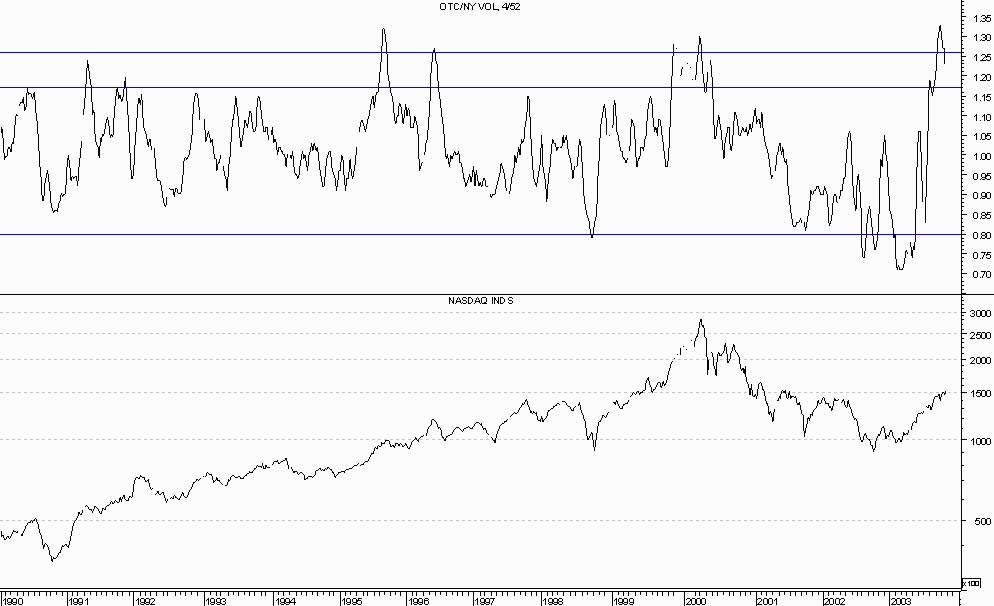Special Report -- September 14, 2003
OUR 4/52 WEEK (NORMALIZED) NASDAQ/NYSE VOLUME RATIO
Back in the 1960's, one of the key indicators analysts used to measure speculative activity in the stock market was the ratio of volume on the American Stock Exchange to volume on the New York Stock Exchange. Unfortunately, the secular decline in Amex volume during the 1970's rendered the ratio ineffectual, and the ratio fell into disuse.
Then, one day in the late 1970's, Tony Tabell came into my office at Putnam with a chart he had just done. Tony thought that the concept of comparing volume on the Amex to NYSE volume was still valid, but the parameters needed redefining. To do this, he decided to "normalize" the ratio by taking a short-term (4-week) moving average of the Amex/NYSE volume ratio and comparing it to a long-term (52-week) ratio. It worked -- and I have been following it ever since. Although more recently, the advent of NASDAQ volume data plus the greater and greater non-equity volume on the Amex caused us to shift our emphasis from the ASE/NYSE volume ratio to the NASDAQ/NYSE volume ratio some time ago (although we still calculate the former, just in case).
And that, in a nutshell, is the story of how and why the 4/52 week (normalized) NASDAQ/ NYSE volume ratio became one of our key indicators. Here's how it's calculated:
1. Calculate the four-week total of NASDAQ volume and the four-week total of NYSE volume. (Our source is the weekly stock volume table in Barrons.) This week, those totals are 32052715 and 24302471.
2. Take a ratio of the four-week totals. In this case, 32052715 divided by 24302471 is 1.319.
3. Add the last 52 four-week ratios together and divide by 52. This week, that number is 1.0225.
4. Finally, divide the four-week ratio, 1.319, by the 52-week ratio, 1.0225, to get the 4/52 week ratio: 1.29. This number - 1.29 -- is the one that we publish on our statistical summary page and on our chart.
Based on past history, the indicator generates a warning when it moves to 1.17, and a rise above 1.26 is a clear sign of present danger. Prior to the current warning, the indicator has generated just three other warnings since 1987: April 1991 (when it hit 1.24), August 1995 (1.32) and March 2000 (1.30). In 1991 and 1995 the NASDAQ went more sideways than down afterwards, falling 8%-9% in 10-16 weeks. The 2000 warning, though, coincided with the NASDAQ's secular top, and the NASDAQ responded by plummeting 34% in just 10 weeks. (Unfortunately, as we noted in Friday's report, none of those precedents seems particularly applicable now.) Based on all this, though, we think the current warning from our 4/52 week NASDAQ/NYSE volume ratio needs to be taken very seriously.
Here's what it looks like now:

-- Walter Deemer
(c)2003 DTR Inc. All Rights Reserved
